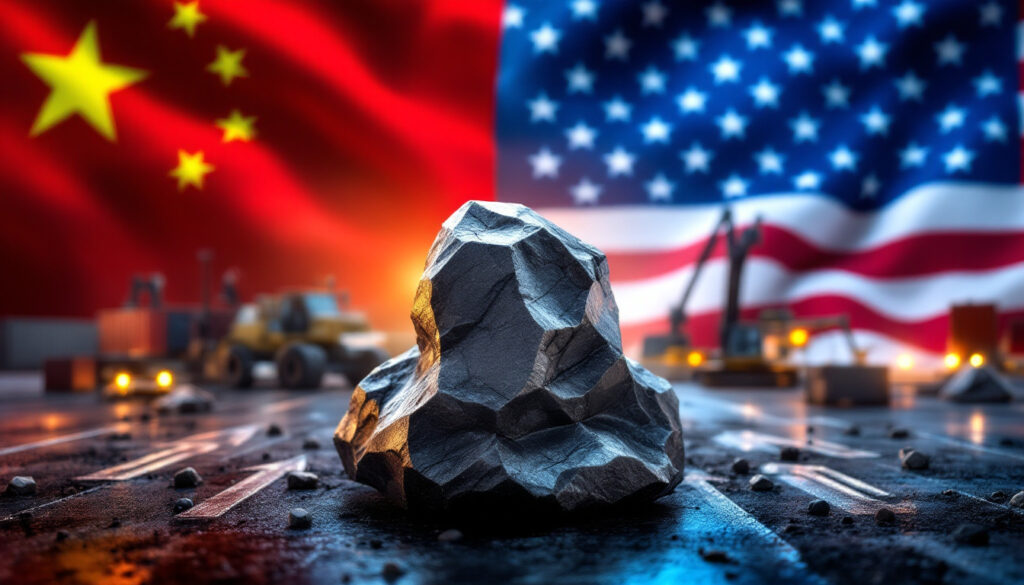What Are the Recent Tungsten Export Restrictions from China?
On February 4, 2025, China sent shockwaves through global industrial supply chains by adding tungsten to its export restriction list. This wasn’t an isolated action but part of a broader strategic measure that included four other critical industrial metals. Since this announcement, the international market has been thrown into disarray as no export permits have been issued for tungsten, effectively freezing procurement channels that many global manufacturers had relied on for decades.
The timing was strategic, coming as direct retaliation against Washington’s 10% tariff increase on Chinese imports, signaling Beijing’s willingness to leverage its dominance over critical mineral supply chains as a geopolitical tool. These US‑China trade war impacts continue to reverberate throughout the global economy.
According to Lewis Black, CEO of Almonty Industries, one of the few significant tungsten producers outside China: “The vast majority of our industry is in absolute panic… Since February they have been unable to procure raw materials.” This stark assessment highlights the immediate disruption that followed China’s policy change.
The February 2025 Export Policy Change
China’s February announcement wasn’t a complete ban but rather a strategic restriction that requires special export permits. However, the practical effect has been nearly identical to a total embargo since the Chinese government has not approved any tungsten export applications in the months following the announcement.
The U.S. Geological Survey confirms China’s overwhelming dominance, noting that the country accounted for an extraordinary 82.7% of global raw tungsten ore production in 2023. This market concentration created a perfect storm when exports suddenly stopped.
The restriction was implemented with minimal advance notice, leaving international buyers with little time to develop contingency plans. Many manufacturers that had optimized their supply chains around ready access to Chinese tungsten suddenly found themselves scrambling to secure alternative supplies.
“This isn’t a temporary trade dispute – it’s a fundamental restructuring of critical mineral supply chains that will have lasting consequences for global manufacturing,” notes Lewis Black, whose company has since seen unprecedented demand for non-Chinese tungsten sources.
Key Industry Impacts
The defense and aerospace sectors were among the first to feel the pressure. For contractors already facing a January 1, 2027 deadline to eliminate Chinese tungsten from their supply chains (as mandated by U.S. defense regulations), these restrictions dramatically accelerated their timeline for finding alternatives.
Manufacturing sectors producing cutting tools, drill bits, and heavy machinery components have reported severe procurement challenges, with some companies implementing rationing systems for their remaining tungsten inventory. The timing has been particularly disruptive as it coincided with post-pandemic manufacturing recovery efforts in many Western economies.
Several major manufacturers have begun exploring alternative processing routes, including:
- Recovery of tungsten from mining tailings and waste streams
- Reactivation of mothballed tungsten mines in Western countries
- Development of new extraction technologies for lower-grade deposits
- Investigation of potential substitute materials where technically feasible
The sudden supply disruption has revealed the vulnerability created by decades of stable Chinese exports that had lulled many industries into supply chain complacency. According to industry analysts, tungsten prices on the international market have shown significant volatility since February, with some specialized grades experiencing price increases of over 30%.
Why Is Tungsten Considered a Critical Metal?
Tungsten holds a unique position among industrial metals due to its extraordinary physical properties and irreplaceable role in numerous high-tech and defense applications. This combination of exceptional characteristics and strategic importance has earned it classification as a critical mineral by numerous governments worldwide.
Unique Physical Properties
Tungsten’s most remarkable characteristic is its extraordinary melting point of 3,422 degrees Celsius (6,192°F) – the highest of any metal on the periodic table. This extreme heat resistance makes tungsten essential in applications where other metals would simply melt, including high-temperature industrial furnaces, rocket nozzles, and specialized welding operations.
The metal also possesses exceptional hardness, particularly when formed into tungsten carbide (WC), which approaches diamond in its ability to resist deformation and wear. This property makes tungsten-containing alloys the material of choice for cutting tools that can maintain their edge even when machining the hardest steel alloys.
Another distinguishing characteristic is tungsten’s remarkable density of 19.3 g/cm³, making it among the densest elements – approximately 1.7 times denser than lead. This extreme density, combined with its high melting point, creates a unique combination that is particularly valuable in aerospace, defense, and nuclear applications.
These properties are enhanced by tungsten’s:
- Excellent electrical conductivity
- Extremely low thermal expansion
- High tensile strength even at elevated temperatures
- Superior resistance to corrosion
When metallurgists and engineers evaluate potential substitute materials, they consistently find that tungsten’s unique combination of properties makes it exceptionally difficult to replace without significant performance compromises.
Essential Applications
Tungsten’s extraordinary properties translate into critical applications across multiple industries:
Manufacturing and Machining
- Tungsten carbide cutting tools account for approximately 60% of global tungsten consumption
- High-speed steel drill bits for machining hardened materials
- Die casting molds that can withstand thousands of production cycles
Aerospace and Defense
- Tungsten-heavy alloys in kinetic energy penetrators and fragmentation warheads
- High-density counterweights in aircraft control surfaces
- Radiation shielding in aerospace and medical applications
- Heat sinks for advanced avionics systems
Clean Energy Technologies
- Specialized turbine blade alloys for wind power generation
- Solar panel production where tungsten wire is used to slice silicon wafers (creating less waste than traditional methods)
- Nuclear reactor components requiring resistance to extreme heat and radiation
Automotive and Transportation
- Wear-resistant components in vehicle engines and transmissions
- Spark plug electrodes that can withstand thousands of ignition cycles
- Vibration damping weights in high-performance vehicles
Electronics and Lighting
- Filaments in incandescent and specialty lighting applications
- Heat sinks in advanced electronics
- Electrical contacts in high-reliability applications
“The modern world as we know it simply couldn’t function without tungsten,” explains Lewis Black. “From the drill bits that extract oil to the cutting tools that manufacture smartphones and the turbine blades that generate clean energy – tungsten is literally embedded in the foundation of modern civilization.”
This critical dependence, combined with China’s near-monopoly on production, creates a strategic vulnerability that extends far beyond simple supply chain economics into the realm of national security and industrial sovereignty. The role of critical minerals in energy transition further highlights the importance of securing supply chains for these resources.
How Concentrated Is the Global Tungsten Supply Chain?
The global tungsten supply chain represents one of the most concentrated mineral markets in the world, with production dominated by a single country to a degree that exceeds even rare earth elements. This extreme concentration creates inherent vulnerabilities that the recent export restrictions have brought into sharp focus.
Current Production Dominance
According to the latest data from the U.S. Geological Survey, China’s tungsten production dominance is staggering:
| Country | Percentage of Global Production (2023) |
|---|---|
| China | 82.7% |
| Vietnam | 4.2% |
| Russia | 2.5% |
| North Korea | 2.0% |
| Others | 8.6% |
This concentration becomes even more pronounced when examining processed tungsten products rather than just raw ore. China’s share of intermediate products like ammonium paratungstate (APT) and tungsten carbide powder exceeds 85% of global capacity.
The geological distribution of tungsten resources is actually less concentrated than production figures suggest. Significant tungsten deposits exist in countries including Australia, Brazil, Canada, Portugal, Spain, the United Kingdom, and the United States. However, economic factors, environmental regulations, and China’s decades-long strategic investment in tungsten production have resulted in the current market imbalance.
A particularly concerning aspect of this concentration is that the United States has not had commercial-scale tungsten mining for over a decade. The last major U.S. tungsten mine, the Pine Creek Mine in California, ceased operations in 2001, leaving America entirely dependent on imported tungsten despite having identified domestic reserves.
Supply Vulnerability Factors
The extreme concentration of tungsten production creates multiple vulnerability factors:
- Limited Redundancy: With over 80% of production in one country, there’s minimal redundancy in the global supply system.
- Processing Bottlenecks: Even when tungsten ore is mined outside China, much of it is still sent to China for processing due to limited refining capacity elsewhere.
- Long Development Timelines: New tungsten mines typically require 7-10 years from exploration to production, meaning supply responses to disruptions are inherently slow.
- Substitution Challenges: Unlike some minerals, tungsten’s unique properties make substitution difficult or impossible in many applications.
- Industry Consolidation: Three decades of readily available Chinese exports led to the closure of mines in Western countries and industry consolidation.
As Lewis Black explains: “The industry has enjoyed 30 years of very stable prices and very stable supply from China. That created a false sense of security.” This complacency resulted in minimal investment in alternative supply sources until the recent crisis.
The vulnerability is particularly acute because the few non-Chinese suppliers face significant challenges:
- Vietnam’s 4.2% global production share comes primarily from the Nui Phao mine, which has faced periodic environmental challenges.
- Russia’s 2.5% contribution is now subject to sanctions in many Western markets, further limiting viable alternatives.
- North Korea’s 2% production is largely inaccessible to Western markets due to international sanctions.
This concentration has created what industry analysts describe as a “perfect storm” for tungsten-dependent industries following China’s export restrictions, highlighting the strategic vulnerability created by decades of supply chain optimization that prioritized cost efficiency over resilience. For a broader perspective, a global mining landscape overview sheds light on how different countries are positioned in the mining sector.
What Are the Defense Industry Implications?
The defense sector faces particularly severe challenges from China’s tungsten export restrictions due to a combination of stringent procurement requirements, strategic material classifications, and looming compliance deadlines that create unique urgency for military contractors.
U.S. Defense Contractor Requirements
U.S. defense contractors are operating under a particularly tight timeline due to legislation requiring the elimination of Chinese tungsten from defense supply chains by January 1, 2027. This requirement, established through the National Defense Authorization Act, was already presenting significant challenges before China’s export restrictions further complicated the situation.
The 2027 deadline represents a significant hurdle for an industry that has traditionally relied heavily on Chinese tungsten for various applications. According to defense industry analysts, this timeline was already considered ambitious, but the recent export restrictions have transformed it from challenging to potentially unachievable without significant government intervention.
Defense contractors face a complex set of requirements:
- Complete supply chain transparency down to raw material sources
- Certification of tungsten origin for all components and subcomponents
- Development of qualified alternative suppliers for specialized tungsten products
- Testing and certification of new material sources to meet stringent performance standards
For many defense applications, tungsten’s unique properties make it particularly difficult to substitute. As one defense industry specialist notes: “You can’t simply replace tungsten with another metal in armor-piercing ammunition or radiation shielding applications—the physics simply don’t work with substitute materials.”
The compliance challenge extends beyond prime contractors to the entire defense industrial base, including thousands of smaller suppliers who may have less visibility into their supply chains and fewer resources to develop alternatives.
Strategic Material Classification
The U.S. government has formally classified tungsten as a strategic and critical material under the Defense Production Act, recognizing its essential role in defense applications and the vulnerability created by supply chain concentration. This classification aligns with broader efforts to implement a defence‑critical materials strategy.
This classification enables several government actions:
- Authorization for the National Defense Stockpile to acquire and maintain tungsten reserves
- Potential Defense Production Act funding for domestic production capabilities
- Eligibility for expedited permitting for new tungsten mining projects
- Research funding for recycling and substitution technologies
The Department of Defense maintains a limited stockpile of tungsten materials as part of its strategic reserves, but industry sources indicate these reserves would be insufficient for prolonged supply disruptions. The exact quantities are classified, but analysts estimate current stockpiles could support critical defense applications for less than six months.
The strategic importance of tungsten extends across numerous military platforms and systems:
- Armor and Anti-Armor Systems: Tungsten’s density makes it critical for kinetic energy penetrators and vehicle armor.
- Precision Guidance: Tungsten’s density makes it ideal for counterweights in precision guidance systems.
- Aircraft Components: Engine components, counterbalances, and high-temperature applications.
- Naval Systems: Specialized ship components requiring corrosion resistance and high density.
- Space and Missile Defense: Heat shields, radiation protection, and specialized components.
Defense officials have begun advocating for an expansion of the Defense Logistics Agency’s tungsten acquisition program and potentially invoking rarely-used authorities to accelerate domestic production capabilities.
“The defense industry faces a dual challenge – complying with the 2027 deadline while simultaneously adapting to China’s export restrictions. This creates unprecedented urgency for developing alternative supply chains,” notes one defense industry analyst.
For NATO allies and other U.S. security partners, the situation is similarly challenging, as many face the same supply disruptions but without the established domestic policy frameworks to address them systematically. This has prompted increased interest in international cooperation on critical mineral security, particularly among Five Eyes intelligence alliance members (U.S., UK, Canada, Australia, and New Zealand).
How Are Companies Responding to the Supply Crisis?
In the face of unprecedented supply chain disruption, companies across multiple industries are implementing diverse strategies to secure tungsten supplies, accelerate alternative sourcing, and reduce their vulnerability to future restrictions. These responses range from short-term tactical adjustments to fundamental strategic shifts in procurement approaches.
Diversification Strategies
Companies are pursuing multiple parallel strategies to diversify their tungsten sources:
1. Revival of Western Mining Projects
Several dormant tungsten mining projects are being rapidly reassessed for potential restart:
- The Hemerdon Mine (also known as Drakelands) in Devon, United Kingdom – once Europe’s largest tungsten mine – is undergoing feasibility studies for reopening after closing in 2018.
- The Sangdong Mine in South Korea is accelerating its development timeline, with Almonty Industries pushing to begin production earlier than originally planned.
- Exploration projects in Canada, Spain, and Australia are receiving renewed attention and investment funding.
2. Advanced Recycling Initiatives
Tungsten’s high value and recyclability make it an ideal candidate for recovery programs:
- Metal cutting companies are implementing closed-loop recycling systems that can recover up to 95% of tungsten from used cutting tools.
- Defense contractors are developing specialized processes to recover tungsten from manufacturing scrap and end-of-life military products.
- Electronic waste processors are enhancing their capabilities to extract tungsten from circuit boards and other components.
Current recycling rates for tungsten globally are estimated at approximately 35-40%, but industry experts believe this could potentially increase to 60-65% with improved collection systems and processing technologies.
3. Efficiency and Substitution Research
Companies are exploring ways to reduce their tungsten dependency:
- Materials scientists are developing nano-structured tungsten carbide that can reduce material use by up to 30% while maintaining performance.
- Research into alternative materials like titanium carbonitride for certain cutting tool applications shows promise for less demanding applications.
- Advanced manufacturing techniques like additive manufacturing are enabling more efficient use of tungsten in complex components.
4. Process Innovation
Technical innovations are emerging to address supply challenges:
- Development of direct reduction processes that can produce tungsten products with fewer intermediate steps.
- Enhanced recovery methods for extracting tungsten from previously uneconomical low-grade ores and tailings.
- Improved processing techniques that can handle tungsten from sources with higher impurity levels.
Alternative Sourcing Initiatives
Companies are forming unconventional partnerships and exploring previously overlooked tungsten sources:
Tailings Recovery Projects
Mining waste from historical operations contains significant tungsten that was uneconomical to recover using older technologies:
- Portuguese mine tailings from operations that closed in the 1980s contain an estimated 12,000 tonnes of recoverable tungsten.
- Historical mining districts in Cornwall, UK, contain substantial tungsten resources in abandoned mines and processing waste.
- Mine waste reprocessing technologies can now economically extract tungsten from tailings with as little as 0.08% tungsten content.
Lewis Black of Almonty Industries notes: “We’ve had customers asking us to recover tungsten from our tailings that we wouldn’t have considered economical before February. The economics have completely changed.”
Strategic Partnerships and Offtake Agreements
Companies are establishing direct partnerships with producers outside China:
- Vertical integration attempts, with end users investing directly in mining projects to secure supply.
- Long-term offtake agreements with price premiums for non-Chinese sources.
- Joint technology development between miners and end users to address specific quality requirements.
Stockpiling and Inventory Management
Companies with sufficient
Want to Spot the Next Major Mineral Discovery?
Discover market-moving ASX mineral announcements before they gain broader attention with Discovery Alert’s proprietary Discovery IQ model, which transforms complex geological data into actionable investment insights. Explore how major mineral discoveries have historically generated substantial returns by visiting Discovery Alert’s dedicated discoveries page and position yourself ahead of the market.




